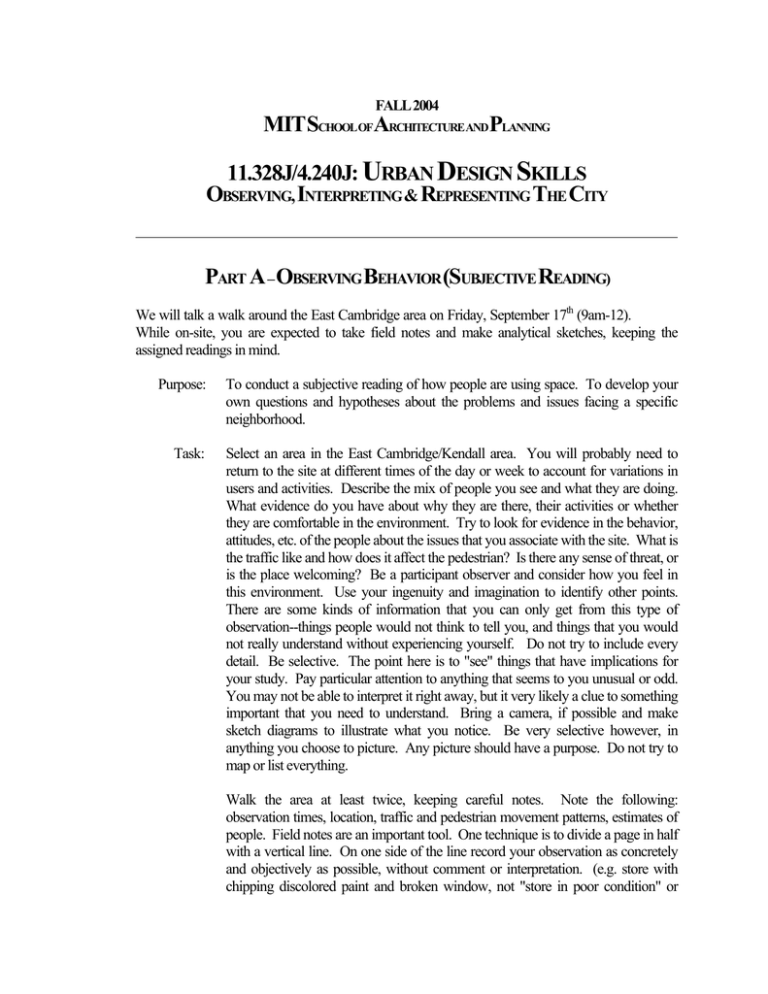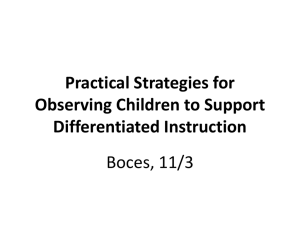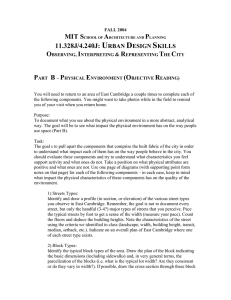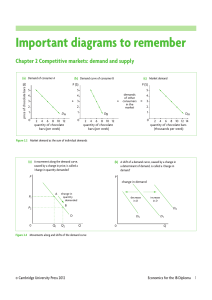Document 13641354
advertisement

FALL 2004 MITSCHOOLOFARCHITECTUREANDPLANNING 11.328J/4.240J: URBAN DESIGN SKILLS OBSERVING, INTERPRETING & REPRESENTING THE CITY PART A – OBSERVING BEHAVIOR (SUBJECTIVE READING) We will talk a walk around the East Cambridge area on Friday, September 17th (9am-12). While on-site, you are expected to take field notes and make analytical sketches, keeping the assigned readings in mind. Purpose: To conduct a subjective reading of how people are using space. To develop your own questions and hypotheses about the problems and issues facing a specific neighborhood. Task: Select an area in the East Cambridge/Kendall area. You will probably need to return to the site at different times of the day or week to account for variations in users and activities. Describe the mix of people you see and what they are doing. What evidence do you have about why they are there, their activities or whether they are comfortable in the environment. Try to look for evidence in the behavior, attitudes, etc. of the people about the issues that you associate with the site. What is the traffic like and how does it affect the pedestrian? Is there any sense of threat, or is the place welcoming? Be a participant observer and consider how you feel in this environment. Use your ingenuity and imagination to identify other points. There are some kinds of information that you can only get from this type of observation--things people would not think to tell you, and things that you would not really understand without experiencing yourself. Do not try to include every detail. Be selective. The point here is to "see" things that have implications for your study. Pay particular attention to anything that seems to you unusual or odd. You may not be able to interpret it right away, but it very likely a clue to something important that you need to understand. Bring a camera, if possible and make sketch diagrams to illustrate what you notice. Be very selective however, in anything you choose to picture. Any picture should have a purpose. Do not try to map or list everything. Walk the area at least twice, keeping careful notes. Note the following: observation times, location, traffic and pedestrian movement patterns, estimates of people. Field notes are an important tool. One technique is to divide a page in half with a vertical line. On one side of the line record your observation as concretely and objectively as possible, without comment or interpretation. (e.g. store with chipping discolored paint and broken window, not "store in poor condition" or "merchants have neglected maintenance”) On the other side of the vertical line put your interpretations, guesses and questions which may warrant further investigation, or which later observation may answer. (e.g. "does this condition reflect poor business conditions, or is it a problem of vandalism?"). If you get some overall ideas and are not sure what specifically prompted them, put them on a separate page. Deliverables: Written document, max. 3 pages text, 3 pages diagrams.


